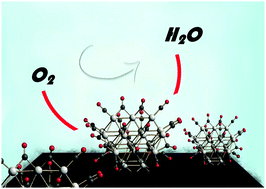Molecular cluster route for the facile synthesis of a stable and active Pt nanoparticle catalyst†
Abstract
In this paper we introduce the use of molecular metal clusters as precursors for the in situ formation of nanoparticles with a high activity and surprising stability as electrocatalysts in energy conversion. The work is relevant in the present quest for remediation of greenhouse gas production and global warming, where fuel cells and metal and lithium air batteries are intended to play a crucial role. The research for an increased efficiency of these devices needs to solve the problems linked to the Oxygen Reduction Reaction (ORR), which plays a key role in these processes, due to its sluggish electrochemical kinetics that must be increased by a suitable electrocatalyst. Here we describe the facile synthesis of a new cathode material for fuel cells based on CO–Pt molecular clusters that are strongly bound to Vulcan XC72R®. The Pt–CO bond can be removed just after the synthesis, by thermal treatment at 450 K, or once in solution, leaving low-coordinated, highly reactive surface Pt atoms. The materials are investigated thoroughly using identical-location transmission electron microscopy, X-ray diffraction (with pair distribution function) and X-ray absorption measurements, revealing an extremely small, yet controlled, particle size (1–2 nm), with high structural and morphological stability, and lack of any aggregation process after thermal treatment. The surprising stability is related to the quite large number of Pt–C bonds that the nanoparticles form with the support, allowing them to attach stably onto the carbonaceous moiety. At the same time, the nanoparticles are particularly strained, and enclose a high defect density, thus enhancing their catalytic properties. The best performing composite presents a mass activity of 225 mA mgPt−1 @ 0.9 V vs. RHE for the ORR, and a less cathodic onset potential compared with a conventional Pt nanoparticle cathode, used as a benchmark under the same experimental conditions, while in turn having a lower noble metal content.



 Please wait while we load your content...
Please wait while we load your content...